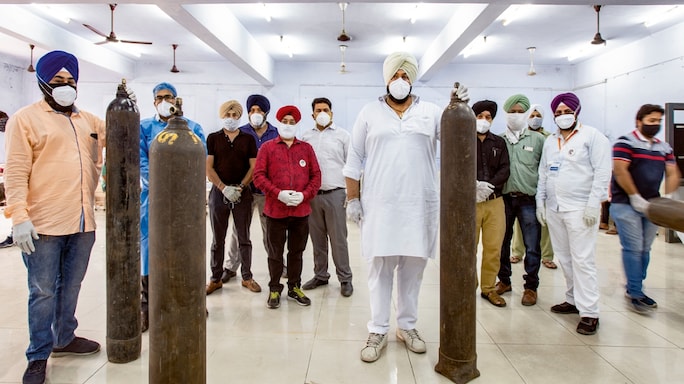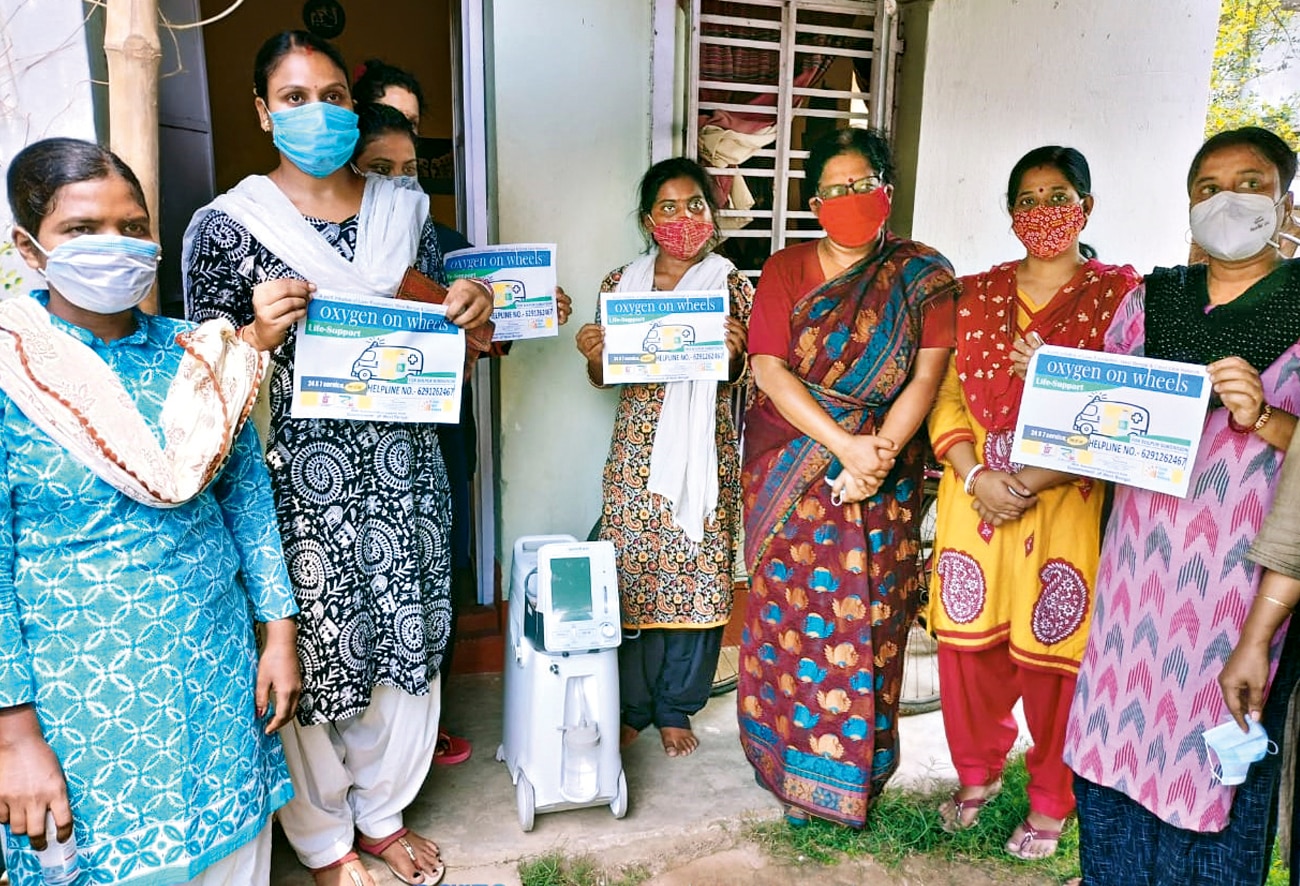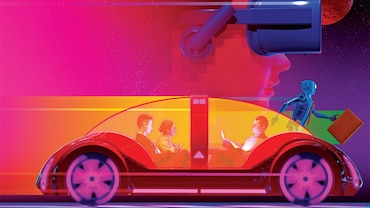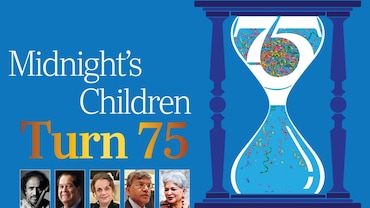- HOME
- /
- Cover Story
- /
They Give Us Hope
As the country coped with the trauma of a second COVID wave, a new set of citizen heroes came to its rescue
 Bandeep Singh
Bandeep Singh
No one, it seemed, had warned us about the second COVID wave. A spike in the number of infections set some alarm bells ringing in March, but none were loud enough to prepare us for the devastation we saw barely a month later. As hospital beds and oxygen became scarce, our very Indian rules of privilege ceased to apply. COVID-19 was, suddenly, the great leveller. Regardless of our position on the ladders of caste and class, we all fought hard to access critical healthcare. We gasped together. We were all desperate. Governments in the country, at the levels of both centre and state, were visibly unprepared. Their complacency created a vacuum.
While some COVID patients needed ambulances and medicine, there were more who, by then, needed hearses. Amidst the ensuing chaos, most of us were left with little idea about which number to call, where to go and what to do. Finally, it was some brave, committed and selfless individuals who stepped in to create that support system. Here were ordinary Indians showing extraordinary courage.
 Versha Verma, whose free hearse service offered COVID victims a dignified final journey
Versha Verma, whose free hearse service offered COVID victims a dignified final journey
Helping shore up India’s frontlines were volunteers and warriors who often put themselves in harm’s way just so that they could alleviate distress. Social worker Versha Verma, for instance, transformed a moment of great personal loss into anopportunity to serve her city of Lucknow: “I lost my best friend to COVID in mid-April. I waited at Ram Manohar Lohia Hospital with her body for four hours. No middle-class family could afford the Rs 10,000 to Rs 15,000 that drivers were charging. The crematorium was only four km away.”
The next day, Verma rented an Omni van and returned to the same hospital, holding a placard that read ‘Nishulk Shav Vahan’ (Free Hearse). The 42-year-old remembers performing the last rites of five COVID patients on her very first day. “At the crematorium, there were 70 to 80 bodies burning. I was wearing PPE in the scorching sun. I thought I would melt or faint. Slowly, however, I got used to it.” When people saw her work tirelessly for over 13 hours a day, they decided to fund her initiative. Verma used this money to employ 12 workers, adding to her fleet three more vans and an ambulance.
Ever since the pandemic struck in 2020, Verma hasn’t stopped to either breathe or despair. She has helped distribute food packets, rations, medicines, blood and plasma to those who need it most. Like her, there are others whose efforts are bringing comfort to countless Indians in these dark, uncertain times.From drivers kitting their rickshaws with oxygen cylinders to schoolchildren coordinating relief efforts onWhatsApp, these modern heroes all seem to be motivated by a deep sense of community, not by a want to profit.With every life they save or better, they give us an India to hope and root for.
*****
Breathing Life into Us
By the third week of April, watching the news had become an anxious, often horrifying experience. Hospitals were turning away severely ill COVID patients. They had no beds, and, in Delhi specifically, many had no oxygen. Pradhan of Shri Guru Singh Sabha Gurudwara in Indirapuram, Ghaziabad, Gurpreet Singh Rummy remembers exactly when the second wave crescendoed at his doorstep—it was 11:30 p.m. on 22 April. A 55-year-old woman had been brought to the gurudwara. Her SpO2 levels had dipped to 50 per cent.“We, thankfully, had some cylinders, but not a lot of knowhow. We some-how brought up her levels up to 95 percent in about an hour,” recalls Rummy.“We made a video of this and put it up on social media. In about an hour,100 to 150 cars showed up. They also had nowhere else to go.”
After Rummy, 44, helped set upKhalsa Help International (KHI) last year, he ensured that the needy get rations, LPG and free COVID tests. The organization even helped patients find hospital beds and treatment. SinceApril this year, however, the scale ofKHI’s operations has increased tenfold.In just three-odd weeks, Rummy and his volunteers had provided oxygen to approximately 12,000 people, but to dothis, they had to source cylinders from Haryana, Punjab, Rajasthan and Uttarakhand. Rummy remembers weeping when KHI’s oxygen stocks once dwindled: “Everyone put up their hands, saying we’ll supply hospitals first, but what about those who didn’t get a bed, people who can’t afford one?”
 Members of the Oxygen on Wheels team in Shantiniketan, West Bengal
Members of the Oxygen on Wheels team in Shantiniketan, West Bengal
In the end, it wasn’t just individuals who benefited from KHI’s unique oxygen langar—health-care facilities did, too. “At least six hospitals had us on call in case they ran out of cylinders. The government couldn’t help them, but they were able to save lives with the oxygen we supplied.” Even though six of KHI’s 90 volunteers have tested positive for COVID, Rummy tells us that none of his colleagues have yetbeen vaccinated. “The work we do is non-stop. People are sometimes down for two or three days after a vaccine. If we’re short even one person, many patients would suffer, patients for whom we’re the only hope,” he says.
In comparison to Delhi, says Dr Abhijit Chowdhury, chief advisor to Kolkata’s Liver Foundation, thesecond wave peaked later in West Bengal. “When it became clear that oxygen would be needed, we felt we needed to rise to the occasion.” On 7 May, using two ambulances which the state government had lent, Liver Foundation volunteers started taking the organization’s 11 oxygen concentrators to those who needed it urgently. It didn’t take long for donors to see the merits of this initiative. In less than a month, the organization had received over 140 concentrators, and with them, greater resolve.
Oxygen on Wheels, Liver Foundation’s 24x7 oxygen-delivery service, was never meant to be an urban, Kolkata-only drive. Dr Partha Sarathi Mukherjee, the foundation’s secretary, says, “News of the oxygen crisis itself created massive panic among people living in small towns and villages. Without big-city facilities, they had no idea about what to do or where to go.” As Liver Foundation looked for partners in rural and remote West Bengal, Dr Chowdhury reached out to Manisha Banerjee, headmistress of a school in Shantiniketan. “I told him[Dr Chowdhury] we want to launch an all-women effort.” she says.
Made up of teachers, students and homemakers, Banerjee’s team of 10 women does everything from running a helpline to driving concentrators around the districts of Bolpur and Birbhum. In villages, says Banerjee, cylinders are either unaffordable or unavailable, “so this seemed like a good initiative”. Moreover, she adds, “It is also helping break stereotypes of the ways in which women can contribute.”
*****
Driving Us to Safety
On 15 April, Dattatraya Sawant heard someone knocking on his door at two in the morning. After having fallen seriously ill, an old lady had come to ask if Sawant could take her to the hospital in his auto rickshaw. She had already been turned down by three other drivers in Mumbai’s Ghatkopar area. “I took her to a nearby hospital,” says Sawant. “I thought What if it had been my mother, ill and unable to get to the hospital. What if it had been me? I figured why not use my auto as an ambulance.”
In metropolises like Mumbai, there are often more critical COVID patients than there are ambulances. Also, as Sawant saw in the case of his ageing passenger, even non-COVID patients were finding it hard to sometimes make that life-saving journey to the hospital. He decided he would not differentiate between the two: “I take everyone who comes to me.” In Sawant’s rickshaw, you can now find an infrared thermometer, sanitizers and a pulse oximeter. Sawant protects himself with PPE and a divider he had installed. In just five weeks, he’d ferried 77 passengers, 42 of whom had tested positive for COVID. Sawant, who is also an English teacher, has not let the dangers of his brave endeavours deter him. “All essential workers such as doctors, nurses, ward boys go to work and stay in contact with COVID patients24x7. What if they stayed home? What would happen to us then? So, I thought it was nothing for me to ferry a few COVID patients.”
Much like Sawant whose initiative has the financial and emotional backing of his wife, Mohammad Javed Khan has also found similar support in his Bhopal home. When he told his wife that the cost of filling the oxygen cylinder with which he had kitted his auto rickshaw was Rs 700 to Rs 800, she agreed to sell her jewellery.
In April, Khan saw on his WhatsApp chats and Facebook wall, pictures we all did—people carrying their ailing parents on their shoulders, young men and women suffering outside hospitals. “If an ambulance did turn up, it would charge people Rs 8,000 for a distance of five or six km. What is a poor person to do? Get himself treated or pay for the ambulance?” asks Khan. Once the 34-year-old had decided he would use his rickshaw to ferry COVID patients in need of transport, help started pouring in. After a journalist shared his Google Pay details, Khan received enough money to put together and distribute ration kits.
 Mohammad Javed Khan began ferrying COVID patients for free and set up an oxygen cylinder in his auto rickshaw to help sustain critical cases on the go.
Mohammad Javed Khan began ferrying COVID patients for free and set up an oxygen cylinder in his auto rickshaw to help sustain critical cases on the go.
Although Khan now has an e-pass that helps him move across the city during lockdown, he recalls a bitter experience with the Bhopal police. On his way to ferry a patient from one hospital to another, he was apprehended by city cops. They accused him of illegally sellingoxygen. By the time this ordeal was over, the patient had passed away. “Why harass those who try to work for a good cause? People need to rally together, not leave each other alone to fend for themselves,” argues Khan.
In Dhar, a tribal district in Madhya Pradesh, Aziz ul-Rahman Khan had also seen harrowing pictures on his social media—husbands carrying on their shoulders their deceased wives, a man pulling a COVID patient in a thela (cart). “I thought I have to invent something that is within everyone’s reach,” says the engineer. The 46-year- old Khan’s invention—portable ambulances that can be attached to motorbikes—will soon be provided to 16 community health centres in Dhar. At the peak of the second wave, Dhar’s 10 ambulances were in no way enough for its thousand-plus COVID patients. Khan is helping plug that gap.
*****
 (Clockwise from top) School students Rishay Gupta, Ansh Garg and Avani Singh set up a lead verification and resource management effort to help connect people in need with reliable information for COVID treatment through WhatsApp.
(Clockwise from top) School students Rishay Gupta, Ansh Garg and Avani Singh set up a lead verification and resource management effort to help connect people in need with reliable information for COVID treatment through WhatsApp.
Marshalling Our Resources
While it was possible to foresee a spike in our collective distress in March, no one had predicted a sudden collapse of the nation’s health systems. With testing kits and oxygen cylinders both in short supply, people soon took to social media. Some were looking for medicine, others for hospital beds. The pleas that circulated on Twitter and on WhatsApp groups made one fact clear—the few resources that were still available needed to be managed. Samaritans, one saw, stepped up before governments.
Seeing havoc unfold around them, Ansh Garg, Rishay Gupta and Avani Singh, three students freshly entering class 12, decided they mustdo something. The teenagers from Meerut and Saharanpur had a student organization—they put it to use. In the melee of appeals for medicines, beds, oxygen and other requests, there was also a lot of information that was either outdated or false. The trio set up two WhatsApp groups—COVID-19 Sahayta Kendra and Sahayta Kendra Volunteers—to verify various leads. “India is a country with a large youth population,” says Garg, 16. “If not us, then who will work?”
The groups, now overseen by more than 300 volunteers, check information from across the country to help connect people in distress to those who can help. The students work in shifts, with calls coming in until two a.m., then abating for a few hours before resuming at five a.m. Garg says that as 16- and 17-year-olds it’s sometimes tough to deal with this much pain and grief on a daily basis, but they do their best.
 The medicine bank started by doctor couple, Marcus Ranney (second from the right) and his wife Raina, services impoverished communities in seven cities.
The medicine bank started by doctor couple, Marcus Ranney (second from the right) and his wife Raina, services impoverished communities in seven cities.
Efforts such as these have sprung up across geographies. In Mumbai, doctor couple Marcus and Raina Ranney began collecting unused medicines in early May. It started with trying to help someone they knew, so they put the word out over WhatsApp in their housing society, asking if anyone had unused and unexpired medicines to spare. This simple effort then became an initiative, one which soon metastasized to cover seven cities where dedicated collection centres and logistics are all now in place.
“If one building can save a life, then imagine what a city or a country can do,” says Marcus Ranney. They have collected more than 200 kg of medicines so far—mostly medication required for light to moderate COVID treatment, including Fabiflu, Dolo, anti-allergics and other drugs for pain-relief. With the help of non-profits, these medicines are then sent to areas or communities that need them. “Others have also been inspired by this template and we are happy to share it,” says Ranney. The doctors hope to continue running their medicine bank in some form even after the pandemic abates.
In Jammu and Kashmir, a group of volunteers called SOSJK offers a motley list of services—connecting people to resources, liaising with hospital authorities, arranging tele-medicine consultations, sourcing RT-PCR tests and medical equipment. “We are a one-stop shop for all COVID-related things,”says Khushboo Mattoo, a volunteer. “We don’t just amplify requests, but do our best to not let a case go without aresolution.” The 180-odd volunteers, divided into eight sub-groups, have successfully assisted more than 300 people in the state, including those in underserved parts. “We try to be a bridge between patients, the administration and available resources,” says volunteer Umesh Talashi.
*****
Dignifying Our Dead
Having worked as a hospital supervisor for 10 years, Majeed Bilal had grown used to death, but last year, he was moved to tears when he saw an old woman die of COVID. “This happened during the first lockdown,” he tells us. “No one was ready to touch her dead body, not even her children.” After having seen municipality officials throw the lady’s body in a pit, Bilal decided he would start conducting the last rites of COVID patients himself. “Soon after starting, I quit my job. No one wanted to be near me.”
Though Bilal’s organization, Humanity First Foundation (HFF), was given two hearses by a donor, he found that not many people in hisarea—Karnataka’s Bidar district—were similarly generous. “We needed food and new PPE kits. I knew I’d have to raise the money myself, so I sold my two plots of land.” With the Rs 10 lakh he received, Bilal has already facilitated 790 funerals. In the last two months, the 31-year-old feels his work has doubled. “Earlier, we used to only take bodies from hospitals. Now we are also getting calls from people’s homes. All the villages here know about HFF. They rely on us.”
Wanting to protect his family, Bilal has been living in a boarding house for over a year. He sometimes sees his wife and children from a distance. “I don’t mind hardship as nothing matches the contentment I feel. If I die for this cause, I’ll consider myself a martyr.” Thankfully, Bilal says, he has tested negative for COVID all of 29 times. He then discloses a figure he holds close to his heart. “We’ve buried only 150 Muslims. The others all belonged to different faiths. We stay true to our name. We put humanity first.”
Much like Bilal, Syed Jalaluddin Zafar has helped give 1,900 COVID patients a respectful farewell. What irks Zafar, a Hyderabad-based publisher, is the lack of official help. Despite having worked since 2020, his organization, Youth Welfare Telangana (YWT), is yet to receive any government support. “We have faced problems on all fronts,” he says. “The government didn’t give us vehicles. Hospitals would first not give us the bodies. Graveyards wouldn’t allow COVID patients to be buried, and the rates charged by crematoriums continues to be exorbitant.” In some cases, adds Zafar, a single cremation can cost as much as Rs 20,000. “We use donations to help poor people get their loved ones cremated.” In 2020, YWT would receive 25 to 30 calls in a week. After 15 March this year, they were fielding 25 to 30 calls every day. “After the second wave hit, there was a day when we got 120 calls,” informs Zafar. “In all of 2020, we conducted the last rites of 900 people. This year, we have already touched 1,000. What’s worrying is that it’s only May.”
 Jatinder Singh Shunty began cremating COVID victims in March 2020.
Jatinder Singh Shunty began cremating COVID victims in March 2020.
Speaking on the phone from Delhi, Jatinder Singh Shunty shares similar figures. Of the 3,500-odd bodies his Shaheed Bhagat Singh Sewa Dal (SBSSD) has cremated since 23 March 2020, around 2,200 were bodies they cremated between 1 April and 16 May this year alone. As Shunty saw the second wave peak, he decided to sleep in his car: “I would spend all day packing bodies, sanitizing them, lighting pyres.In the event I’d picked up the infection, I didn’t want to give it to my family.” Shunty remembers his phone ringing through the night. “I’d get calls from NRIs, wanting me to arrange funerals for their loved ones. I’d sometimes show them the last rites on a video call,” says the Padma Shri recipient.
Not one to give in to despair, Shunty prefers silver linings. “I started SBSSD with one old car I’d bought in 1995. Today, we have a fleet of 25 vehicles that have all been donated to us. Someone gives diesel, another petrol. People in India all have a big heart. Why worry?”
—REPORTING BY SHREEVATSA NEVATIA, ISHANI NANDI, NAOREM ANUJA AND BHAVYA DORE






